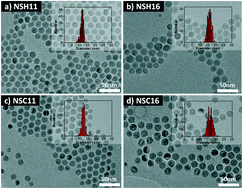Effect of reaction environment and in situ formation of the precursor on the composition and shape of iron oxide nanoparticles synthesized by the thermal decomposition method†
Abstract
In this work, we investigate the effect of the reaction environment and the in situ formation of an iron precursor on the synthesis of iron oxide nanoparticles (IONPs) through thermal decomposition. Spherical IONPs with a spinel Fe3−xO4 structure were synthesized reproducibly through the thermal decomposition of iron stearate (Fe(stearate)2) assisted by oleic acid in octyl ether or eicosene solvents under air. Under similar conditions and by adjusting only the reaction environment, namely under argon, core–shell FeO@Fe3−xO4 NPs with the same sizes were obtained. On the other hand, the thermal decomposition of iron oleate (Fe(oleate)3) in the presence of a mixture of oleic acid and sodium oleate, under air and argon, leads to the formation of cubic-shaped NPs with a similar FeO@Fe3−xO4 structure. Cubic NPs with a homogenous Fe3−xO4 composition were synthesized from the iron oleate formed in situ from FeCl3·6H2O and sodium oleate reactants, which was immediately decomposed. The composition and shape dependence on the experimental conditions, i.e. atmosphere and iron complex, is discussed. The synthesized NPs were characterized by combining several techniques including transmission electron microscopy (TEM), scanning-TEM, X-ray diffraction (XRD) and 57Fe Mössbauer spectrometry. The correlation between the crystalline composition and the magnetic properties was investigated by carrying out magnetization measurements as a function of the applied field and temperature. The spherical and cubic-shaped NPs with a core–shell structure display exchange bias coupling due to the interaction between the antiferromagnetic (AFM) core and the ferrimagnetic (FiM) layer at the surface, while the Fe3−xO4 NPs exhibit a saturation magnetisation lower than that for the bulk counterpart due to the oxidation effects and the presence of a spin canted layer at their surface.



 Please wait while we load your content...
Please wait while we load your content...